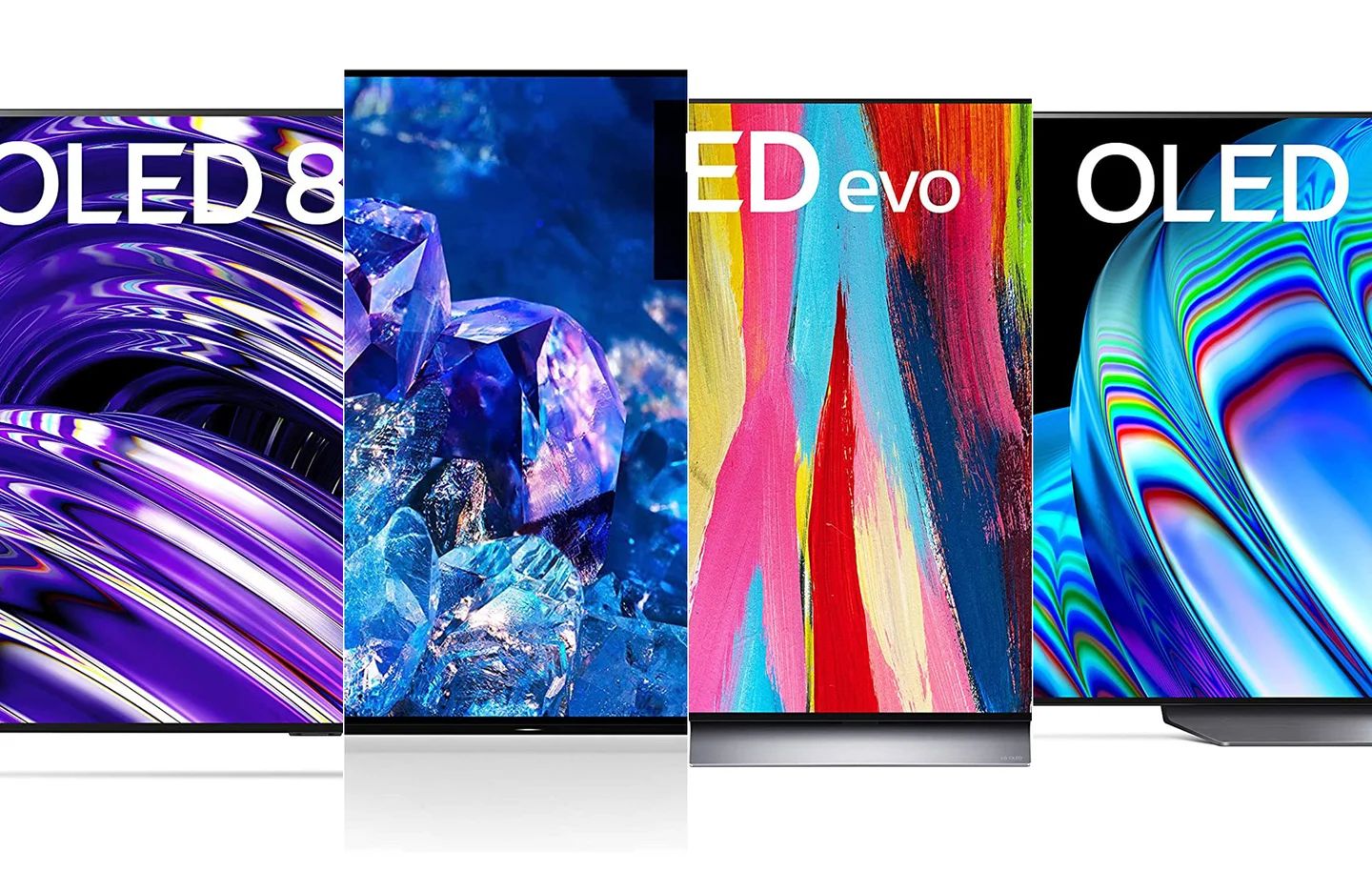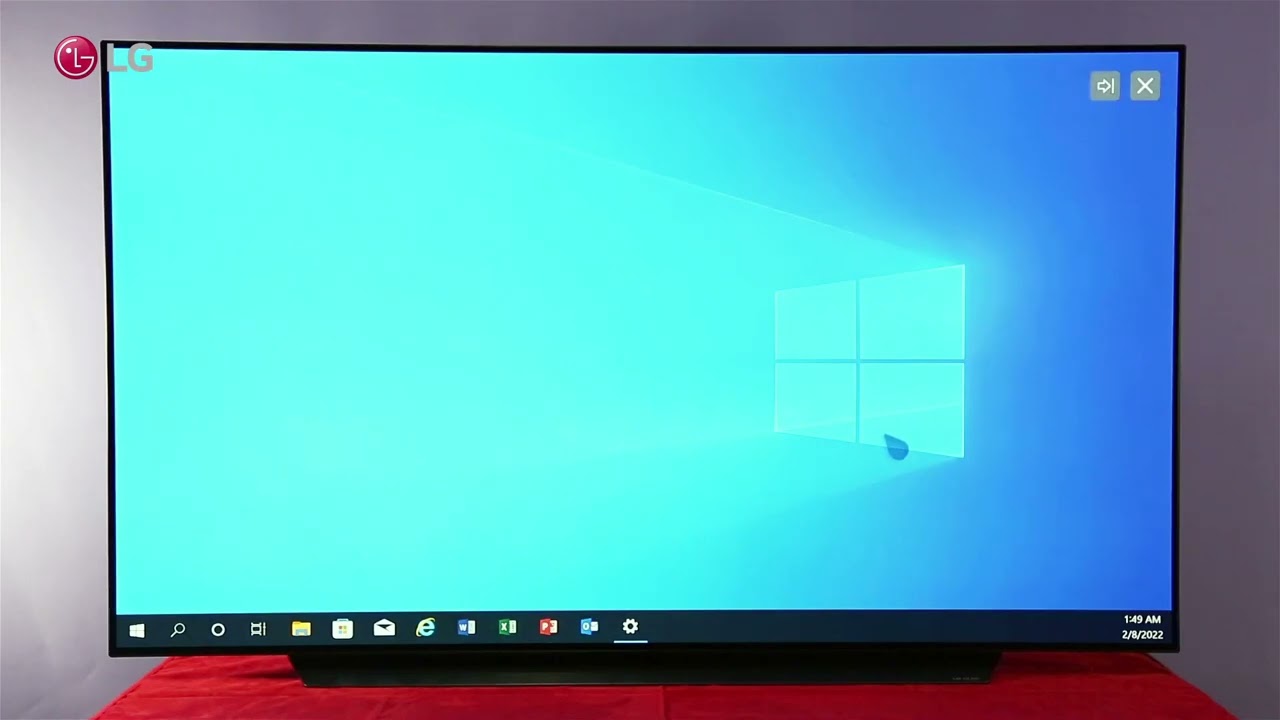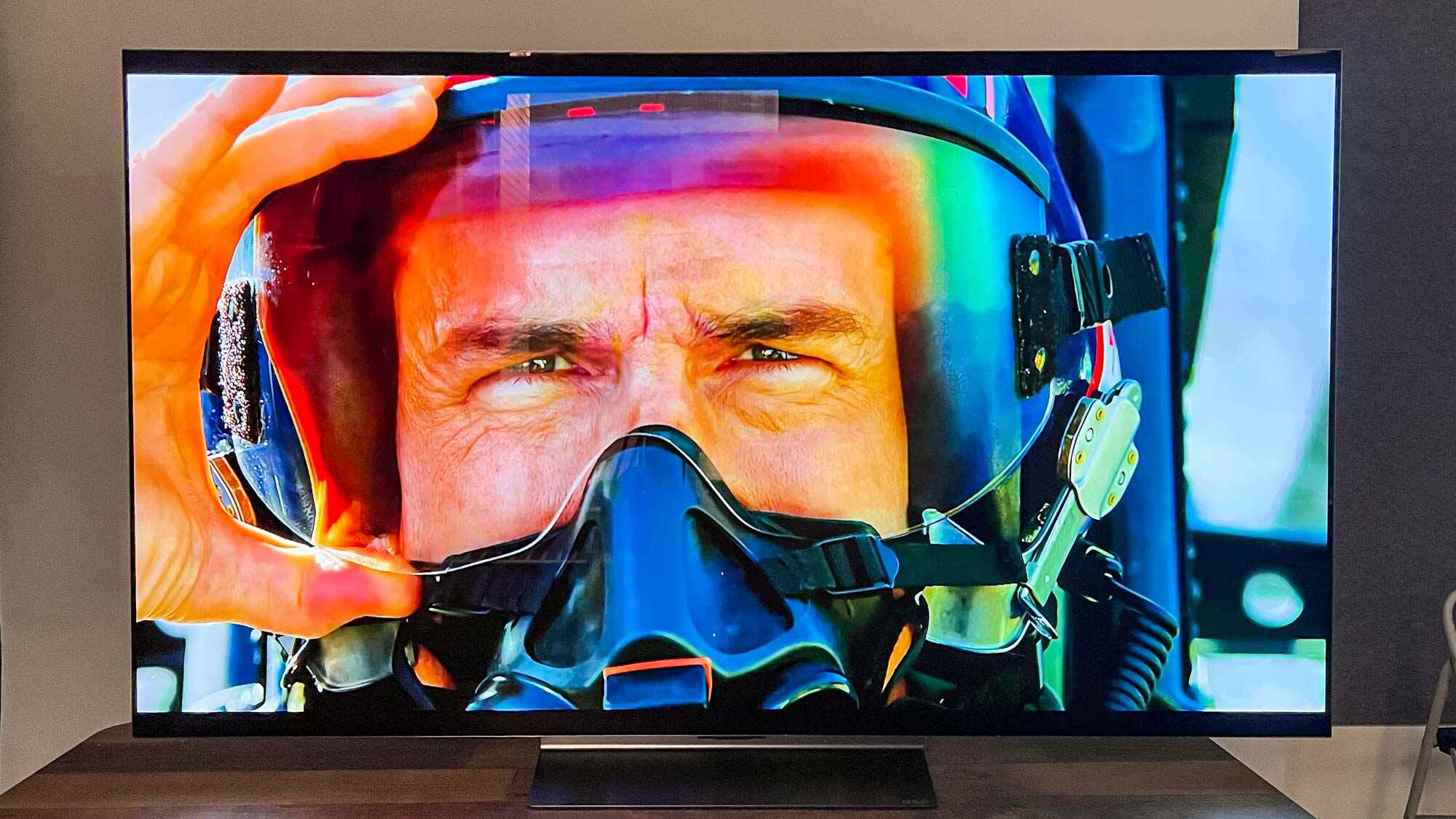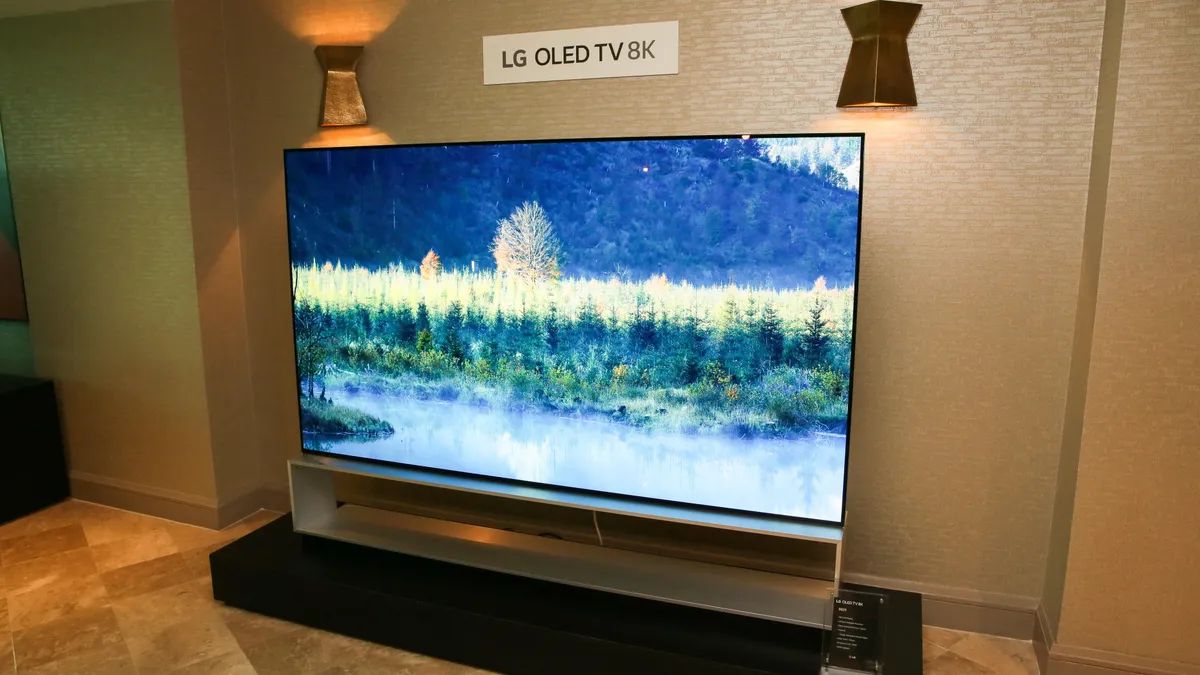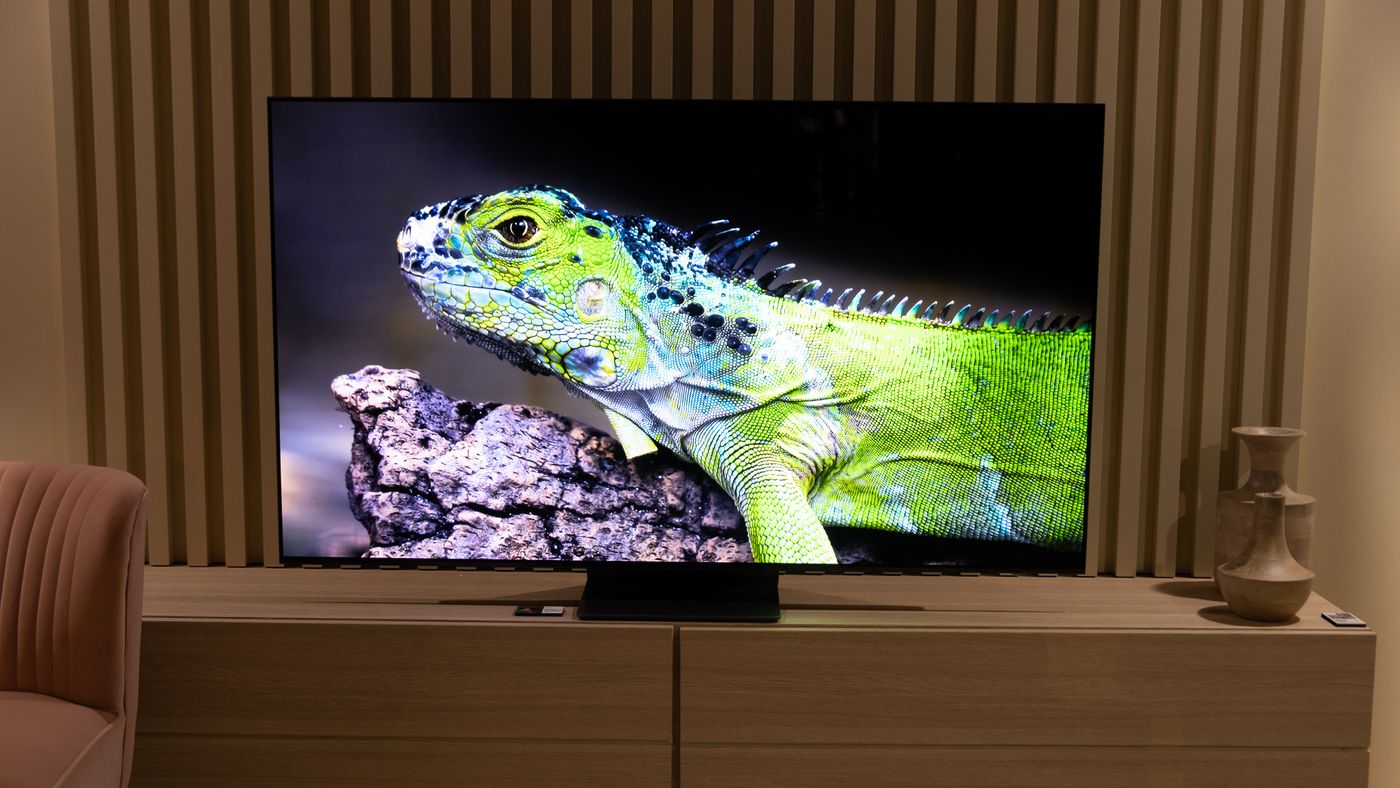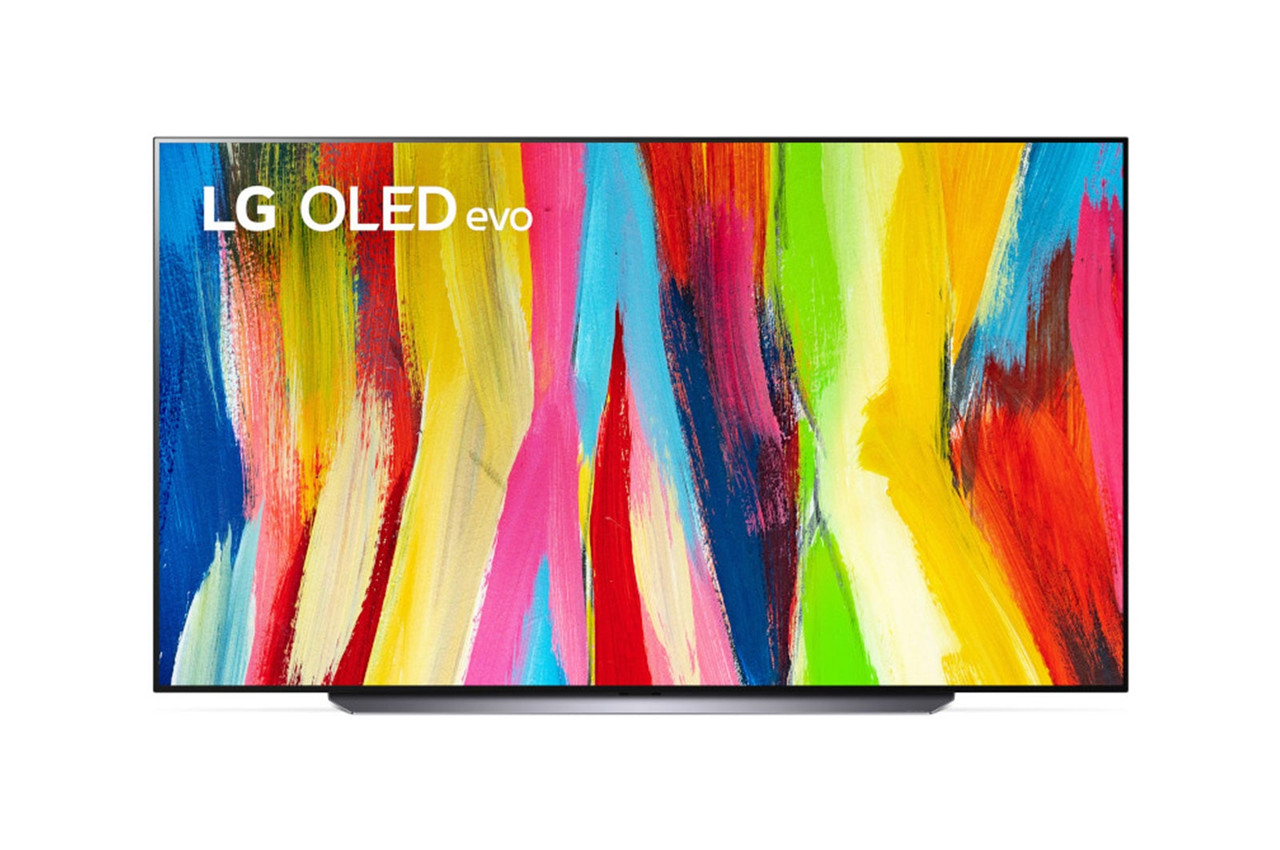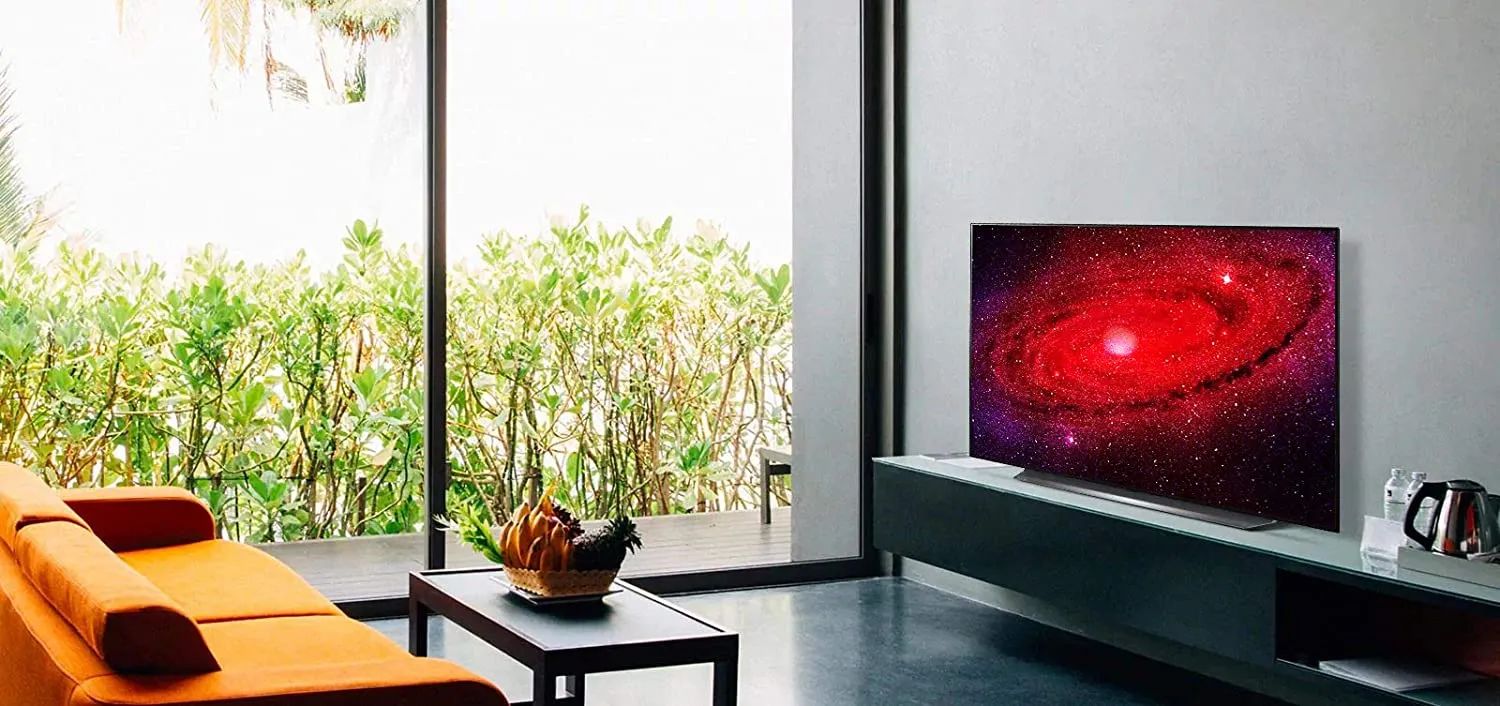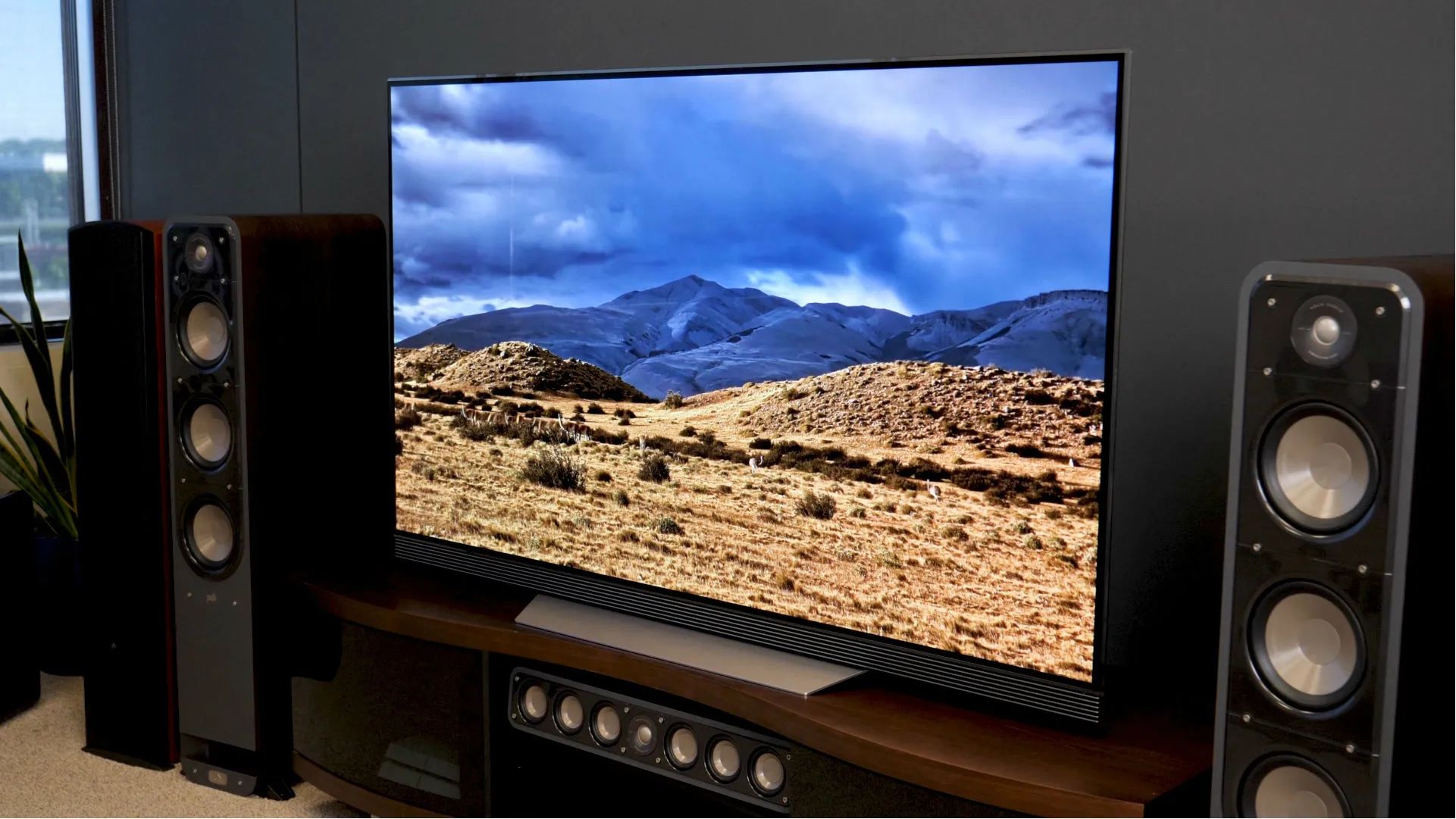Introduction
Welcome to the exciting world of LG OLED TVs! If you’re the proud owner of a brand-new LG OLED TV or planning to get one soon, this article will guide you through the process of setting up your TV. Whether it’s your first time setting up a TV or you’re upgrading from an older model, we’ve got you covered with easy-to-follow steps.
An LG OLED TV offers a stunning visual experience with its vibrant colors, deep blacks, and incredible picture quality. It’s packed with advanced features, smart functionality, and seamless integration with other devices, making it a fantastic entertainment hub for your home.
In this guide, we’ll walk you through everything you need to know to set up your LG OLED TV. From unboxing and placement to connecting cables, configuring settings, and exploring the smart TV features, we’ll cover it all. Whether you’re a tech enthusiast or just looking for a hassle-free setup process, this guide will ensure you get the most out of your LG OLED TV.
Before we dive into the step-by-step instructions, it’s important to ensure that you have all the necessary equipment and cables ready. Make sure you have a stable internet connection, an HDMI cable for connecting external devices, and the TV remote control within reach. With everything in place, let’s now begin the setup process and unlock the full potential of your LG OLED TV!
Unboxing the LG OLED TV
Unboxing your LG OLED TV is an exciting moment as you unveil the sleek and stylish design of your new entertainment centerpiece. Follow these steps to safely unbox your TV:
- Find a well-lit area with enough space to unpack the TV. Make sure to have a clean surface such as a table or floor to place the TV on.
- Carefully cut the seal or tape on the box using a cutter or scissors. Take your time to avoid damaging the contents inside.
- Gently open the box and remove the foam or protective materials covering the TV.
- Slowly lift the TV out of the box, making sure to take proper precautions if it is a larger model. Enlist the help of a friend if needed.
- Place the TV on a soft surface to avoid scratching the screen. You can use the foam or protective materials that came with the box.
- Remove any additional packaging materials such as plastic bags or covers from the TV.
- Inspect the TV for any visible damage. If you notice any, contact LG customer support immediately for assistance.
- Take a moment to appreciate the elegant design and slim profile of your LG OLED TV.
Unboxing your LG OLED TV is the first step towards an immersive entertainment experience. By following these simple steps, you ensure that your TV is handled with care and ready for the next stage of the setup process.
Placing the LG OLED TV
Deciding on the perfect placement for your LG OLED TV is crucial for optimal viewing and overall enjoyment. Here are some factors to consider when determining where to place your TV:
- Choose the right room: Select a room where you’ll be spending most of your time watching TV. Consider factors like lighting, acoustics, and the overall layout of the room.
- Find the ideal viewing distance: The distance between your seating area and the TV affects the viewing experience. As a general rule, aim for a distance that is about 1.5 to 2.5 times the size of the TV screen.
- Positioning for comfortable viewing: Ensure that the TV is at a height and angle that allows for comfortable viewing without straining your neck or eyes. Wall-mounting or using a TV stand can help achieve the right viewing position.
- Avoid direct sunlight: Placing your TV in direct sunlight can cause glare on the screen and affect the picture quality. Position the TV away from windows or use curtains and blinds to control the amount of light entering the room.
- Consider room layout and aesthetics: Take into account the overall room layout and aesthetics when deciding where to place your TV. It should fit harmoniously with the rest of the furniture and decor.
Once you’ve considered these factors, you can proceed with placing your LG OLED TV. Ensure that the TV is stable and secure in its position to prevent any accidents. Double-check the connections and cables to ensure they are easily accessible from the viewing position.
By selecting the right room, finding the ideal viewing distance, and considering the room layout, you can create an immersive and comfortable viewing experience with your LG OLED TV.
Connecting Power and Cables
Before you can start enjoying your LG OLED TV, you need to connect the power cord and necessary cables. Follow these steps to ensure a proper and secure connection:
- Locate the power cord: Unravel the power cord that came with your LG OLED TV. Ensure that the cord is long enough to reach the nearest power outlet.
- Connect the power cord: Insert one end of the power cord into the corresponding slot on the back of the TV. Make sure it is securely connected.
- Plug into a power outlet: Locate a nearby power outlet and plug the other end of the power cord into it. Ensure that the outlet is properly grounded.
- Connect to cable or satellite box: If you plan to watch TV through a cable or satellite box, connect the HDMI or other appropriate cables to the corresponding ports on the TV and the box. Ensure a secure connection.
- Connect to external devices: If you have other devices such as a gaming console, Blu-ray player, or soundbar, connect the necessary cables to the appropriate ports on the TV and the respective devices.
- Check the connections: Give all the cables a gentle tug to ensure they are securely connected. Loose connections can result in audio or video issues.
- Organize the cables: Use cable management solutions like zip ties or cable clips to keep the cables neat and organized behind the TV. This will help minimize clutter and make future troubleshooting easier.
Once you have successfully connected the power cord and necessary cables, you are one step closer to enjoying your LG OLED TV. The power cord provides the TV with the necessary electricity, while connecting audio and video cables ensures seamless communication with external devices. Take a moment to ensure all the connections are secure before moving on to the next steps of setting up your TV.
Setting Up the Remote Control
The remote control is your gateway to accessing and controlling the features of your LG OLED TV. To set it up, follow these simple steps:
- Insert batteries: Open the battery compartment on the back of the remote control and insert the batteries. Ensure that the polarity is correct.
- Check the remote’s compatibility: Make sure that the remote control is compatible with your LG OLED TV model. Refer to the user manual for specific instructions if needed.
- Power on the remote control: Press the power button on the remote control to turn it on. You may need to wait a few seconds for it to initialize.
- Pair the remote control: If your LG OLED TV supports Bluetooth connectivity, follow the on-screen instructions or refer to the user manual to pair the remote control with the TV. This step may not be necessary if your remote control uses infrared (IR) technology.
- Test the remote control: Press various buttons on the remote control to ensure they are working properly. Check functions like volume control, channel selection, and menu navigation.
- Enable universal control (optional): Some LG OLED TVs offer the ability to control other devices, such as a set-top box or soundbar, with the remote control. If applicable, follow the on-screen instructions or refer to the user manual to set up universal control.
Setting up the remote control is a quick and straightforward process. Once it is successfully paired and working, you will have full control over your LG OLED TV’s features and functions. Take a moment to familiarize yourself with the buttons and their respective functions to make navigating the TV’s menu effortless.
Turning On the LG OLED TV
Now that you have set up the remote control, it’s time to turn on your LG OLED TV. Follow these steps to power on your TV:
- Locate the power button: On the front or side panel of the TV, locate the power button. It is typically marked with a power symbol or the word “Power”.
- Press the power button: Press the power button once to turn on the TV. You may hear a startup sound or see the LG logo appearing on the screen.
- Wait for the TV to boot up: Give the TV a few moments to boot up and initialize. This process may take a minute or two.
- Check the LED indicator: Some LG OLED TVs have an LED status indicator. It will typically light up to indicate that the TV is powered on and ready for use.
- Adjust the volume: Press the volume up or volume down buttons on the remote control to adjust the volume. Confirm that the sound is audible and at your desired level.
Turning on your LG OLED TV is a simple process. Once powered on, you’ll be greeted with stunning visuals and exceptional picture quality. If the TV doesn’t turn on, double-check the power connections and ensure that the power outlet is supplying electricity. Troubleshoot any issues by referring to the user manual or contacting LG customer support.
Configuring the Initial Setup
After turning on your LG OLED TV, you’ll be prompted to configure the initial setup. Follow these steps to get your TV up and running:
- Select the preferred language: Choose the language you want to use for the TV’s menu and settings. Use the arrow keys on the remote control to navigate and the OK button to confirm your selection.
- Choose the country/region: Select your country or region from the provided list. This helps the TV optimize certain settings based on your location.
- Agree to the terms and conditions: Read through the terms and conditions, privacy policy, and any other agreements presented on the screen. If you agree, select the checkbox or press the OK button.
- Configure the date and time: Set the correct date and time for your TV. You can usually choose to set it automatically or manually. If available, opt for automatic time updates to ensure accurate timekeeping.
- Perform channel tuning (optional): If you plan to watch over-the-air broadcasts, you’ll need to perform channel tuning to scan and save available channels. Follow the on-screen instructions to complete this process.
- Set up external devices (optional): If you have connected external devices, such as a cable/satellite box or gaming console, follow the on-screen prompts to configure the input sources for these devices. This allows seamless switching between sources using the TV’s remote control.
- Sign in to your LG account (optional): If you have an LG account, you may be prompted to sign in to access additional features and personalized content. Follow the on-screen instructions to sign in or create an account.
Configuring the initial setup of your LG OLED TV is essential for personalized and optimal performance. Take your time to carefully follow the on-screen instructions and customize the settings according to your preferences. Once the initial setup is complete, you can proceed to explore the various features and functions of your LG OLED TV.
Connecting to Wi-Fi
Connecting your LG OLED TV to a Wi-Fi network allows you to enjoy a variety of online features and streaming services. Follow these steps to connect your TV to Wi-Fi:
- Access the Settings menu: Press the Settings button on your remote control to access the TV’s settings menu.
- Select the Network option: Navigate to the network settings by using the arrow keys on your remote control. Select the Network option and press the OK button.
- Enable Wi-Fi: In the network settings, locate the Wi-Fi option. Make sure it is enabled or turned on.
- Scan for available networks: Select the option to scan for available Wi-Fi networks. The TV will search for nearby networks and display them on the screen.
- Select your Wi-Fi network: From the list of available networks, choose your Wi-Fi network. If your network is hidden, select the option to manually enter the network name (SSID).
- Enter the Wi-Fi password: If your Wi-Fi network is secured, you’ll need to enter the Wi-Fi password or network security key. Use the on-screen keyboard or the arrow keys to navigate and input the password.
- Connect to the network: After entering the password, select the option to connect to the network. Wait for the TV to establish a connection with the Wi-Fi network.
- Confirm the connection: Once the connection is established, you’ll see a confirmation message or an indicator that the TV is connected to Wi-Fi.
Connecting your LG OLED TV to Wi-Fi opens up a world of possibilities, including streaming your favorite shows, accessing online content, and interacting with smart features. Ensure that you have a stable internet connection for seamless streaming and browsing. If you encounter any issues during the connection process, refer to the user manual or contact your internet service provider for assistance.
Tuning and Setting Up Channels
Tuning and setting up channels on your LG OLED TV allows you to access over-the-air broadcasts and enjoy a variety of TV programs. Follow these steps to tune and set up channels:
- Access the Settings menu: Press the Settings button on your remote control to access the TV’s settings menu.
- Select the Broadcasting option: Navigate to the broadcasting or channel settings by using the arrow keys on your remote control. Select the Broadcasting option and press the OK button.
- Scan for channels: In the channel settings menu, select the option to scan or search for channels. Choose between automatic or manual channel scanning, depending on your preference and location.
- Wait for the scan to complete: The TV will scan for available channels over the air. This process may take a few minutes. Ensure that your TV antenna or cable connection is properly connected during the scan.
- Preview and save channels: Once the scan is complete, the TV will display a list of available channels. Preview each channel to ensure it is clear and properly tuned. Save the channels by selecting the save or confirm option. This step may vary depending on your TV model.
- Organize the channel list: If desired, you can rearrange the order of the channels or delete unwanted channels. Use the channel management or edit options in the settings menu to customize your channel list.
- Set up channel labeling (optional): Some LG OLED TVs allow you to customize the channel names or assign favorites to specific channels. Refer to the user manual or settings menu for instructions on labeling and organizing channels.
By tuning and setting up channels on your LG OLED TV, you can access a variety of over-the-air broadcasts and enjoy your favorite TV programs. Take your time to scan for channels and arrange them according to your preferences. If you experience any signal issues or have trouble tuning specific channels, ensure that your antenna or cable connection is properly installed and consider adjusting the antenna position for better reception.
Adjusting Picture and Sound Settings
Adjusting the picture and sound settings on your LG OLED TV allows you to optimize the audio and visual experience according to your preferences. Follow these steps to adjust the picture and sound settings:
- Access the Settings menu: Press the Settings button on your remote control to access the TV’s settings menu.
- Select the Picture and Sound options: Navigate to the picture settings or sound settings by using the arrow keys on your remote control. Select either the Picture or Sound option and press the OK button.
- Adjust the picture settings: In the picture settings menu, fine-tune the brightness, contrast, color, and other picture elements. Use the remote control’s arrow keys to navigate through the options and adjust the settings to your liking.
- Customize the sound settings: In the sound settings menu, you can modify the volume, bass, treble, and other sound parameters. Experiment with different preset sound modes or manually adjust the equalizer settings to achieve the desired audio experience.
- Enable any additional features: Your LG OLED TV may offer additional picture and sound enhancement features such as motion smoothing, surround sound, or audio presets. Explore the settings menu to enable these features and customize them based on your preferences.
- Preview the changes: As you make adjustments to the picture and sound settings, preview the changes on your TV screen. Take note of any noticeable improvements or changes in the audio and visual output.
- Save the settings: After fine-tuning the picture and sound settings, save the changes by selecting the save or confirm option, typically found at the bottom of the settings menu.
Adjusting the picture and sound settings on your LG OLED TV allows you to enhance your viewing and listening experience. Play around with different settings to find the perfect balance that suits your preferences and the content you’re watching. Remember to periodically revisit these settings to adapt to different viewing conditions or when switching between different types of content.
Running Software Updates
Keeping your LG OLED TV’s software up to date is crucial for optimal performance and access to the latest features and improvements. Follow these steps to run software updates:
- Access the Settings menu: Press the Settings button on your remote control to access the TV’s settings menu.
- Select the General option: Navigate to the general settings by using the arrow keys on your remote control. Select the General option and press the OK button.
- Check for software updates: In the general settings menu, locate the Software Update or System Update option. Choose the option to check for updates. This will initiate a search for available software updates.
- Download and install updates: If a software update is available, select the option to download and install it. The TV will automatically connect to the internet and begin the update process. This may take several minutes, so be patient.
- Do not power off the TV: During the software update, it is important not to power off the TV or disconnect it from the power source. Doing so may interrupt the update process and cause issues with the TV’s software.
- Wait for the update to complete: Once the software update is downloaded and installed, the TV will restart to apply the changes. It may take a few moments for the TV to complete the update and restart.
- Verify the software version: After the update, verify the software version in the settings menu. This step ensures that the update was successful and that your TV is running the latest software version.
Regularly running software updates on your LG OLED TV ensures that you have access to the latest features, bug fixes, and performance improvements. It is recommended to enable automatic updates if your TV offers the option. This way, your TV will automatically check for updates and install them in the background, keeping your TV up to date without any manual intervention.
Exploring Smart TV Features
One of the key advantages of owning an LG OLED TV is its smart functionality, which opens up a world of exciting features and content. Take the time to explore the smart TV features and make the most of your viewing experience:
- Smart Home Dashboard: The smart home dashboard serves as the central hub for accessing various smart features and apps. Explore the dashboard to discover shortcuts, recommendations, and personalized content.
- Streaming Services: LG OLED TVs offer access to popular streaming services like Netflix, Hulu, Amazon Prime Video, and more. Locate the app store or dedicated button on your remote control to download and explore these services.
- Content Discovery: Some LG OLED TVs feature content discovery features that recommend new shows, movies, or videos based on your preferences or viewing history. Take advantage of these personalized recommendations to discover new content easily.
- Web Browsing: With built-in web browsers, you can surf the internet directly on your TV screen. Use the remote control or a wireless keyboard to search for information, browse websites, or even shop online.
- Voice Control: Many LG OLED TVs offer voice control capabilities, allowing you to control your TV using voice commands. Use the dedicated voice control button or activate the voice command feature to navigate, search, and control your TV hands-free.
- Screen Mirroring and Casting: Share content from your smartphone, tablet, or laptop to your LG OLED TV using screen mirroring or casting features. This allows you to stream videos, photos, or even play games on the big screen.
- Gaming Features: Some LG OLED TVs offer gaming-specific features, such as low input lag, variable refresh rate, or auto game mode detection. If you’re a gamer, explore these features and optimize your gaming experience.
- Additional Apps and Features: LG’s smart platform offers a wide range of additional apps and features to enhance your entertainment. Explore the app store to download and enjoy apps for news, sports, weather, lifestyle, and more.
Take your time to explore the smart TV features on your LG OLED TV. Experiment with different apps, customize settings, and make use of the smart capabilities to fully enjoy the vast world of entertainment at your fingertips.
Customizing the Home Dashboard
The home dashboard of your LG OLED TV is your personalized gateway to accessing apps, settings, and content. Customizing the home dashboard allows you to tailor it to your preferences and make navigation more efficient. Follow these steps to customize the home dashboard:
- Access the Settings menu: Press the Settings button on your remote control to access the TV’s settings menu.
- Select the Home Dashboard option: Navigate to the home dashboard settings by using the arrow keys on your remote control. Select the Home Dashboard option and press the OK button.
- Manage and rearrange apps: In the home dashboard settings, you’ll find options to manage and rearrange apps. Select this option to view all installed apps and rearrange their positions on the dashboard. Move your most frequently used apps to the top for easier access.
- Remove unwanted apps: If there are apps that you no longer use or want on the home dashboard, select the option to remove or uninstall them. This helps declutter the dashboard and keep it more organized.
- Add favorite apps: If there are apps that you frequently use but aren’t currently on the home dashboard, select the option to add or pin apps. This allows you to include your favorite apps directly on the dashboard for quick access.
- Customize app shortcuts: Some LG OLED TVs allow you to set shortcuts or quick access buttons for specific features or apps. Explore the home dashboard settings to customize these shortcuts based on your preferences.
- Explore additional customization options: Depending on your TV model, there may be additional customization options available. These may include adjusting the layout, theme, or background of the home dashboard. Refer to the user manual or settings menu for more information.
By customizing the home dashboard of your LG OLED TV, you can personalize your viewing experience and make interactions with your TV more efficient. Take advantage of the customization options available to create a home dashboard layout that suits your needs and preferences.
Pairing External Devices
Pairing external devices with your LG OLED TV allows you to expand your entertainment options and enjoy content from various sources. Follow these steps to pair external devices with your TV:
- Identify compatible devices: Determine which external devices you want to connect to your LG OLED TV. This may include devices such as a Blu-ray player, gaming console, soundbar, or streaming device. Ensure these devices are compatible with your TV’s input ports.
- Connect the device: Use the appropriate cables to connect the external device to the corresponding input port on your TV. HDMI cables are commonly used for high-definition video and audio signals. Refer to the user manual of your specific device for detailed connection instructions.
- Turn on the external device: Power on the external device and ensure it is set to the correct input source. Some devices automatically detect the connection and switch to the appropriate input source, while others may require manual selection.
- Select the input source on the TV: Use the input/source button on your TV’s remote control to select the input source corresponding to the connected external device. This tells the TV to receive signals from that device.
- Follow device-specific pairing instructions: Depending on the external device, you may need to follow specific pairing instructions. For example, if you are pairing a Bluetooth-enabled device, you may need to put it in pairing mode and search for it from your TV’s Bluetooth settings.
- Confirm the pairing: Once the external device is successfully connected and paired, you should see the audio and video signals from that device displayed on your LG OLED TV. Make any necessary adjustments to ensure proper synchronization and compatibility.
- Test the functionality: Test the functionality of the external device by playing a media file, game, or streaming content. Ensure that audio and video output are working as expected. Adjust settings on both the TV and the external device to achieve the desired experience.
Pairing external devices with your LG OLED TV enhances the versatility and functionality of your entertainment system. Take advantage of the different input ports and connectivity options available to connect external devices and enjoy a seamless multimedia experience.
Setting Up Streaming Services
Setting up streaming services on your LG OLED TV allows you to access a vast library of movies, TV shows, and multimedia content. Follow these steps to set up streaming services:
- Access the app store: Use the remote control to navigate to the app store on your LG OLED TV. Look for the icon or menu option that leads to the app store.
- Search for the desired streaming apps: Once in the app store, search for the streaming apps you want to install. Popular options include Netflix, Hulu, Amazon Prime Video, Disney+, and many others.
- Select and install the apps: After finding the desired streaming apps, select them to view more information. Choose the option to install or download the app onto your TV. Wait for the installation process to complete.
- Sign in or create an account: Open the installed streaming app and sign in with your existing account details. If you don’t have an account, follow the instructions to create a new account.
- Activate the app (if required): Some streaming apps may require activation. Activate the app by visiting the provided URL on your computer or mobile device and entering the activation code shown on your TV screen.
- Customize app settings: Within each streaming app, you’ll find settings to personalize your experience. Explore the options to adjust video quality, subtitles, parental controls, and other preferences.
- Browse and enjoy content: Once the streaming apps are successfully set up, browse through the available content library. Use the remote control or on-screen navigation to select and play your favorite movies, TV shows, or other media.
- Explore additional streaming services: If you’re interested in exploring more streaming services, return to the app store and search for additional apps. Install and set up other streaming services to expand your entertainment options.
Setting up streaming services on your LG OLED TV provides an extensive catalog of on-demand content at your fingertips. Take the time to explore and customize each streaming app to enhance your viewing experience and stay up to date with the latest movies and TV shows.
Configuring Additional Devices (Soundbar, Gaming Console, etc.)
Configuring additional devices, such as a soundbar, gaming console, or other peripherals, with your LG OLED TV enhances your audio and gaming experience. Follow these steps to configure additional devices:
- Identify the device input ports: Determine the input ports on your LG OLED TV where you can connect the additional devices. Common input options include HDMI, optical audio, or Bluetooth.
- Choose the appropriate connection method: Depending on the device and available input ports, choose the appropriate connection method. HDMI is commonly used for high-quality audio and video signals, while optical audio is used for digital audio transmission. Bluetooth is suitable for wireless audio connections.
- Connect the device: Use the appropriate cables to connect the additional device to the corresponding input port on your LG OLED TV. Ensure a secure and snug connection.
- Power on the device: Turn on the additional device, such as the soundbar or gaming console. Make sure it’s set to the correct input/source to receive signals from the TV.
- Select the input source on the TV: Use the input/source button on your TV’s remote control to select the input source matching the connected additional device. This enables the TV to transmit audio and video signals to the device.
- Adjust audio settings: Access the audio settings on your LG OLED TV to specify the audio output source. Select the connected device, such as the soundbar, to ensure audio is routed correctly.
- Configure device-specific settings (if required): Depending on the additional device, you may need to configure specific settings to optimize its performance. Refer to the user manual or device settings for instructions on adjusting settings like video resolution, audio output format, or gaming-specific features.
- Test functionality: Test the functionality of the additional device by playing audio, video, or engaging in gaming. Ensure that the audio is coming from the correct device and that video signals are transmitted properly.
Configuring additional devices with your LG OLED TV enhances the overall audio quality and gaming experience. Take the time to properly connect and configure each device to ensure seamless integration and optimal performance. Consult the user manuals of the additional devices for detailed instructions on specific settings or features.
Enabling and Using Voice Commands
Enabling and using voice commands on your LG OLED TV provides a convenient and hands-free way to control your TV and access various features. Follow these steps to enable and use voice commands:
- Ensure remote compatibility: Check if your LG OLED TV remote control supports voice commands. Some models may require a separate remote or additional accessory for voice control functionality.
- Set up the remote for voice commands: If your remote control supports voice commands, follow the instructions in the user manual to enable this feature. Typically, you’ll need to pair the remote with the TV and initiate the voice command setup process.
- Configure voice control settings: Access the settings menu on your TV and locate the voice control or voice recognition settings. Customize the language, sensitivity, and other voice control parameters according to your preferences.
- Activate voice control: Press the dedicated voice command button on your remote control to activate the voice control feature. It may be represented by a microphone symbol or a specific button labeled for voice commands.
- Speak your command: Hold down the voice command button and speak your command clearly and audibly into the remote’s microphone. You can say commands like “Open Netflix,” “Turn up the volume,” or “Search for action movies.”
- Wait for the TV to process: After speaking your command, wait a moment for the TV to process your voice input. It will analyze your command and perform the corresponding action.
- Explore voice command capabilities: Experiment with different voice commands to control various aspects of your TV, such as changing channels, adjusting settings, opening apps, or searching for content. Refer to the user manual for a list of supported voice commands.
- Fine-tune voice command experience: If you encounter difficulties or inaccuracies with voice commands, return to the voice control settings and adjust the sensitivity or language settings. This can help optimize the voice control experience.
Enabling and using voice commands with your LG OLED TV offers a convenient way to interact with your TV and control its features without using the remote control. It simplifies navigation and enhances accessibility, making it easier than ever to enjoy your favorite shows and movies.
Troubleshooting Tips
Despite the advanced technology and reliable performance of LG OLED TVs, occasional issues or glitches may arise. Here are some troubleshooting tips to help you resolve common problems:
- No power or display issues:
– Ensure that the power cord is securely connected to both the TV and the power outlet.
– Check if there is a power outage in your area.
– Try unplugging the TV for a few minutes and then plugging it back in to perform a power cycle.
– If the issue persists, contact LG customer support for further assistance. - No sound or audio issues:
– Make sure the TV’s mute function is disabled.
– Verify that the audio cables are properly connected to the TV and the external devices.
– Access the TV’s audio settings and ensure that the correct audio output source is selected.
– Check if the external device’s volume is adjusted appropriately.
– If the issue persists, consider resetting the TV’s audio settings or contacting LG customer support. - Poor picture quality or distorted image:
– Check the video input connections and make sure they are securely connected.
– Ensure that the cables you are using support the resolution and capabilities of your TV.
– Adjust the picture settings on your TV to improve the image quality.
– If watching through a streaming service, verify that your internet connection is stable and sufficiently fast.
– If the issue persists, consult the user manual for further troubleshooting steps or contact LG customer support. - App or streaming issues:
– Ensure that your TV’s software is up to date by running the latest software updates.
– Check your internet connection to ensure stable and adequate bandwidth.
– Close and restart the problematic app or streaming service.
– Delete and reinstall the app if necessary.
– If specific apps continue to have issues, contact the app’s support team or reach out to LG customer support for guidance. - Remote control problems:
– Replace the batteries in the remote control if it is not responding.
– Make sure there are no obstructions between the remote control and the TV.
– Check if there is interference from other devices that may be affecting the remote control’s signal.
– If the issue persists, try resetting the remote control or using an alternative remote control if available.
Keep in mind that these troubleshooting tips are general suggestions and may not resolve all issues. For more specific or complex problems with your LG OLED TV, refer to the user manual or contact LG customer support for expert assistance tailored to your specific situation.
Conclusion
Setting up your LG OLED TV is an exciting journey that opens the doors to a world of immersive entertainment and advanced features. From unboxing the TV to configuring settings, connecting external devices, and exploring smart TV capabilities, you now have the knowledge and tools to make the most out of your TV.
By following this guide, you have learned how to unbox your LG OLED TV safely, place it in an optimal position, and connect it to power and various devices. You have also discovered how to set up and customize the remote control for seamless control over your TV. Moreover, you have explored essential steps like turning on the TV, configuring the initial setup, connecting to Wi-Fi, tuning channels, adjusting picture and sound settings, running software updates, and utilizing voice commands.
With the ability to set up streaming services, pair external devices, customize the home dashboard, and troubleshoot common issues, you are well-equipped to navigate and make the most of your LG OLED TV. Remember to periodically check for software updates and explore the ever-growing range of smart TV features to stay ahead of the curve.
Enjoy the stunning visuals, immersive sound, and endless entertainment options that your LG OLED TV brings to your living room or home theater. Sit back, relax, and indulge in a truly impressive viewing experience with your new LG OLED TV!







